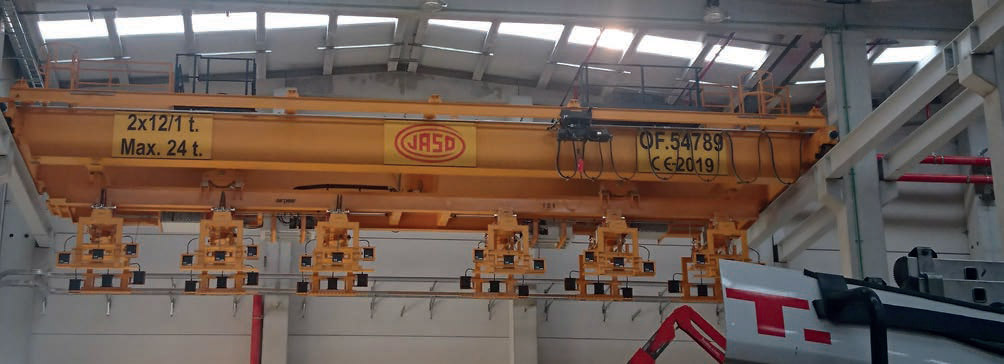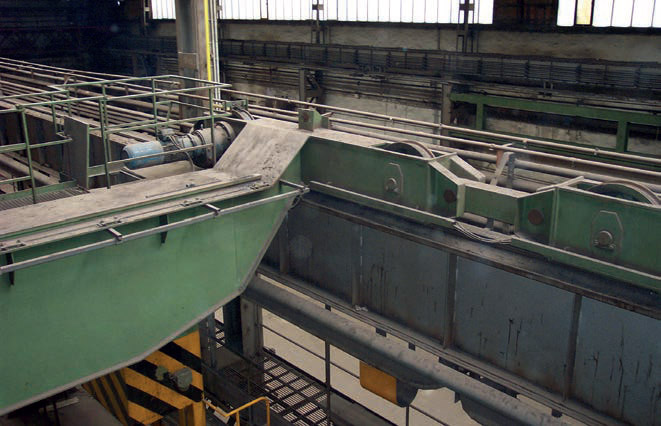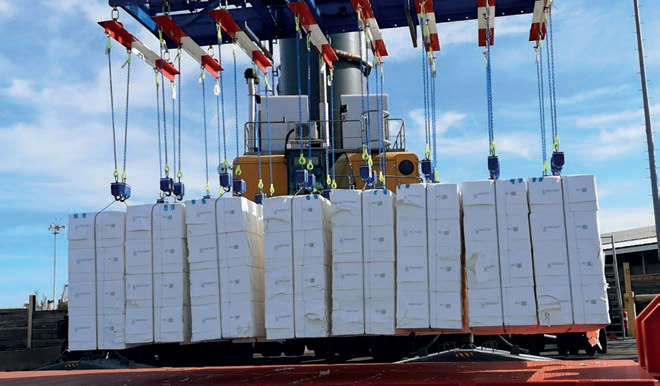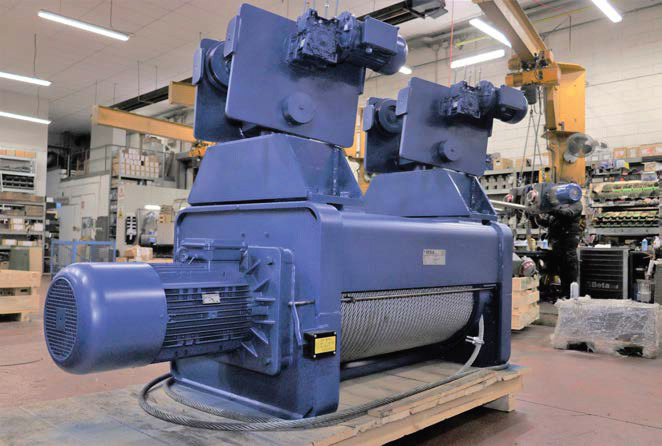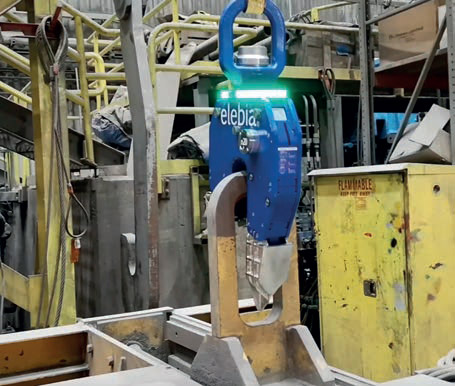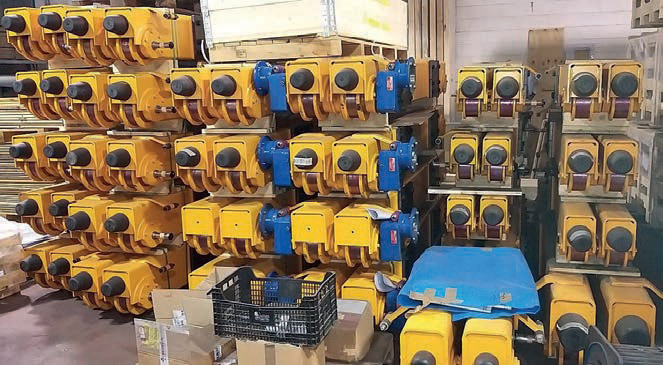Southern Comfort
31 March 2021The market for hoists and factory cranes in Southern Europe is by no means as dire as some, in light of the pandemic, might have been led to believe. Julian Champkin finds optimism amongst its peers.
Southern Europe as far as geography is concerned stretches approximately 4,000km from Spain along the length of the Mediterranean to Greece and the Balkans. The market for hoists can be expected to vary accordingly.
There are of course some constants, though, of which the pandemic is the largest and most glaring.
If we start at the western end of the continent, Spain has crane and hoist manufacturers Jaso, and also Elebia, the world-renowned makers of specialist below-the hook equipment.
“Every country has its own particularities, but generally speaking the pattern is almost the same everywhere, and this includes Northern as well as Southern Europe,” says Esteve Fornells, marketing manager, Elebia. “COVID-19 has hit Europe fiercely:
“The market in France, Italy and Spain has certainly been greatly impacted by the pandemic,” he says. “Many companies in different sectors and industries have suffered prolonged lockdowns, which have affected not only sales but also workers and the workforce in general with layoffs, furloughs and temporary employment regulations. The lifting industry has also been greatly affected by this pandemic. On a more positive note, we can say that most projects have been temporarily frozen rather than abandoned. General feedback from clients and customers is that investments are on hold until the pandemic is under control and general conditions return to a “new normal”. There is still plenty of uncertainty, and we cannot yet talk about signs of recovery.”
And the ‘new normal’ will be different from the old: “This prolonged situation has forced many companies not only in Southern Europe, but worldwide, to reinvent themselves and to ‘think out of the box’,” he says. “Their approach to their day-to-day activity will change.
“But, there is still plenty of pentup demand for lifting equipment as industries will start to pick up where they left off. All economies are keen on moving forward; pending projects will be put into motion once again, new projects will arise and the economy will slowly get in motion once more as the world needs to keep on turning.” No cause then for despair: “The outlook in general is positive,” he says.
And, despite the pandemic, Elebia was able to bring new products to the market last year. “In 2020 we introduced the S40 Automatic Shackle. This product has widened our reach in the lifting industry.
Under the same fail-safe principle as the rest of our lifting products, the S40 shackle is specifically oriented to loads with a lifting lug with a hole or padeye, and applications such as silos and wind turbines,” he says.
“We have also launched the NEO100 lifting hook, our newest solution for lifting and transporting any load, as well as for oversized lifting points of up to 180mm diameter. It is capable of lifting up to 100 kgs. (220 lbs.), with a 4:1 safety factor and advanced safety and productivity features.” Far from regressing during the pandemic, this represents Elebia’s biggest lifting hook to date.
“2021 will probably also see the launch of a couple of completely new products which are in heavy demand.
We have received many enquiries in the past regarding the subsea sector and specifically designed products for load dropping. We think now is the right time to offer these products as we clearly see an important increase and demand of these solutions for a variety of applications. We have new hardware/software applications like the IOH, Internet of Hooks, where the hooks can be configured, set-up and monitored remotely. We are also working on developing a spreader beam with retractable slings to facilitate the attachment and release of C6 lifting clamps when the application is for pipe handling/lifting. So, there are plenty of new developments for 2021.”
Jaso is similarly upbeat about prospects. “In general the countries in the south of Europe are recovering well,” says Antonio Naranjo, their sales and marketing manager. “For standard lifting equipment the market has been improving: it is better now than it was in the summer of 2020, which is understandable given the worldwide situation. At JASO we have been noticing that the steel sector and the wind energy sector are performing better year by year even with the COVID-19 pandemic.
“Our intentions for 2021 are to increase our presence in the southern European countries. We are geographically close to them, which gives us an advantage, and JASO Industrial has launched several new products and we want to promote them. One that is new is transfer carts (AGVs, or automated guided vehicles); we see great possibilities for this product, especially in the wind energy sector for handling the windmill blades. As I mentioned, the sector is increasing year by year and we see great possibilities for this product.”
Italy
In Italy, Misia has been manufacturing hoists from its base near Milan since the 1980s. It is a company that perhaps wisely in an uncertain world does not commit itself to forecasts. But it too is not downhearted: “Even though 2020 left us with not what you could call sweet dreams in our lives, 2021 is at least starting with good potentials,” says Sabrina Bellini. export manager, Misia, a small family-owned company, as many of its clients; and Italy as a whole, she says, seems well-placed for the recovery in general and for small flexible companies in particular.
“We have never been happy predicting forecasts,” she says, “but what we can say is that in almost 39 years of experience we have learned that the world needs people who are able to do things and develop things and this is particularly true now, given the pandemic. The lifting market needs technicians, and the new Italian government will be led by a good technician.” [Mario Draghi is in the process of forming a government at the time of writing.] “For that reason we think that pandemic recovery funds will be spent effectively, tending towards the country’s infrastructure and business support.
“And even the rise in the costs of raw materials, although worrying in terms of stability of price lists for manufactured products, is an indication that there is demand in the economy and increases the hopes for a good outlook. We believe that even the initial problems of Brexit, with trade slowing down with the reintroduction of customs, will be solved very soon.
“We receive increasingly complex requests from our customers,” says Bellini, “and we are ready and happy to fulfil these. It must be said that in our field introducing modern innovations is not always easy. Electronics, for example, guarantees better safety – through more efficient load limiters, anti-sway systems, sensors, data loggers and so on – but many customers see in it greater complexity, more elements that can potentially break down and which need experts to understand, higher maintenance costs, and higher spare parts costs. Some still prefer simplicity. So we try to keep available options of traditional solutions such as, for example, the conical rotor motor with mechanical brake.
“It is almost certain that in the not-too-distant future we will see only inverter motors. At present, though, the choice is still conditioned by the cost difference, which is still in favour of double polarity motors; and there is also a preference among many customers for the traditional conical rotor motor.
“Italy has been facing as all the other countries a terrible pandemic, but we always feel proud that our manufacturing economy is made of small and medium players such as ourselves and many of our customers. This makes us flexible and able to adapt our knowledge to erect the bespoke crane that is wished for by our customers – who are also very often small- and medium-sized companies like ourselves. We can offer flexibility and very quick service, as well as a good price / quality ratio, which make us different from our big competitors.
“This business model is not about big industry standardization, but still we are able to export, and the ‘Made in Italy’ label is always well accepted and recognized for the clear but excellent engineering concepts we are able to develop.
“That said, we also serve big Italian manufacturers who invest money in standardization and automation of their manufacturing and who allow us to demonstrate that we provide safe and reliable products. The scenario is rich and varied and the pandemic has reconfirmed that the values of our company are ones that work.”
Greece
Moving eastwards, Gerasimos Koutsouvelis is the country director for Konecranes Greece. “Following the long downturn sparked by the financial crisis of 2007-2008, the Greek lifting market started to grow again by the latter half of the last decade,” he says; “It was showing healthy development especially in 2019 and early 2020. The coronavirus pandemic hit the country hard, especially its critical tourism industry, and this had knock-on effects throughout the broader economy. But the country has continued its investments in industry and digitalization. As a result, 2020 saw an increase in GDP in the industrial sector and supporting lifting business sector.
“Moving into 2021, there are a number of promising-looking sectors for Konecranes: aluminium, shipyards (both in new ships and repairs), the mining and marble industries, energy, and general manufacturing are all hopeful. Konecranes Greece also supports Albania, Bulgaria, North Macedonia and Cyprus, and in these countries Waste-to-Energy and energy show potential.
In 2018, Konecranes won a project for explosion-proof cranes from the Trans- Adriatic pipeline, which operates a natural gas transportation infrastructure from the Greek border with Turkey to Southern Italy; In 2019 we delivered three large cranes – the largest was 170t – to Elval for operation and installation of their four-stand tandem aluminium hot finishing mill.
“Greece is riding a wave of increasing optimism,” he says. “Business expectations and consumer confidence are up, and investment growth is expected to improve productivity and competitiveness. From January this year steps have been taken to reduce corporate and personal taxation.
“At the same time, there have been efforts to reduce bureaucracy and simplify licensing, and to facilitate largescale investments. The biggest wager is whether the current pandemic-hit economic climate, people’s perceptions and new legislation can be transformed into an investment wave on all fronts.
“In addition, accelerating the digital strategy and overhauling public administration structures are crucial for Greece’s first wave adaptation to the Fourth Industrial Revolution.”
Another major Greek manufacturer is light hoist maker Niko, which has a presence in the US and Europe as well as its home country. “We recently completed the development of our new range of aluminium cranes for loads up to 500kg and 7 metre bridge length, to cover the demand for lighter crane profiles,” says marketing manager Maria Forti. “Four aluminium profiles are available - in both plain and reinforced variants - along with support brackets, end carriages and joints, so a complete aluminium crane can be provided.
“We have been providing certified fall arrest systems since 1998, and this year we managed to enrich the range with new products. An example is the new NIKO workstation bridge crane with reinforced tracks. It is certified by TUV Austria and it allows multiple users to cover a wider working area while protecting them in case of a fall.
We are also scaling up our digital on-line crane configurator to create a more interactive and useful tool for the buyer and end user. It will provide a 3D overview of the crane system they have selected and will minimize the quotation time, so the customer will have a thorough perception of the system he is purchasing, and step files will be at the user’s disposal for further editing if he adds to or changes the system.”
For Greece, the Balkans are an adjacent market. Economies here have been far from strong for many years, and this has provided a niche for Tsiolis cranes, based in Thessaloniki. Its main business is the reconstruction and installation of used hoists and cranes; “We are the only company, as far as I know, in the Balkans to do such a thing,” says owner Ioannis Tsiolis.
“Demand for used and reconstructed cranes has been high since 2009, when the global financial crisis started,” he says.
“There is demand for new cranes as well, but those are either part of an investment that is partially funded by the EU or part of a project, which is funded by the government. In such cases it is mandatory for the crane to be new. But generally most private companies in Greece and the Balkans do not have sufficient funds for investments and banks do not give credit for it since they are sometimes in a worse condition than their customers.
Moreover, a crane is not the machine that will produce their final product, but a tool to make production easier. As a result, investing in a used or reconstructed crane will save money but will not affect the final product of the company if it is not brand new.”
Tsiolis’ business model is in some ways the reverse of companies that make new cranes – preference for used rather than new cranes rises in bad times and falls in good ones - and his experience has also been different:
“Our annual turnover was not affected in 2020 since we had lots of projects running that happily were not abandoned or postponed. However, 2021 does not look promising. January 2021 was the worse month of the last decade for us.
Many of our partners have found the same. Probably everyone thought in February 2020 that the COVID pandemic would end soon, probably during summer, so in 2020 not many businesses were held back. Now that the pandemic is much worse than everybody initially expected, everybody is sceptical about investing,” he adds.
But, as with Konecranes, the hydropower and marble industries are providing him business “We have customers who require cranes of 10t-50t capacity for small hydro-power stations in Greece and the Balkans. Hydro-power is doing well all over the region. We have many customers in the marble industry in Greece, Albania and Kosovo,” says Tsiolis.
“We also have customers who work with construction materials - glass industries, steel bars and the like - in Albania and Kosovo. I would say that Kosovo is at its peak in that field. Exports of Greek marble are going well but construction in Greece has been contracting since 2009. Just to mention that 15 years ago we used to construct around 20 five- or six-tonne gantry cranes per year for companies that merchandise steel bars. In 2019, we only constructed three such cranes and we bought six used gantry cranes from bankrupted companies of the same sector. Inside Greece we sell cranes from 3.2t to 32t capacity. Outside Greece we sell only cranes of 10t capacity and higher. Abroad, the cost of transporting and installing a small crane absorbs the price saving over a new small crane, so it is not economic to export smaller ones.
“In small capacity cranes under 3.2t the price difference over a new one of same technical specs and brand name could be 30%. In high-capacity cranes, of say 50t, the saving could be around 70% of the price.
“Around 60% of our sales is outside Greece. We have sold cranes to Albania, Bulgaria, North Macedonia, Romania, Georgia, the Middle East, India, Bangladesh and spare parts in more than 60 countries. A large project that was delivered at the end of 2020 was a reconstructed 80/5t gantry delivered in Albania.
“We buy our used cranes mainly from Germany and from Greece. We tend to combine the girders of the Greek cranes with the equipment from German ones to construct the crane the customer requires. We modernise the cranes to new standards, adding limit switches, thermal protection on the motors and so on, but there is little demand for full digital controls.”
It would seem, then, that the crane market throughout Southern Europe is far from stagnating. Post-pandemic, people everywhere seem to be looking for growth.
